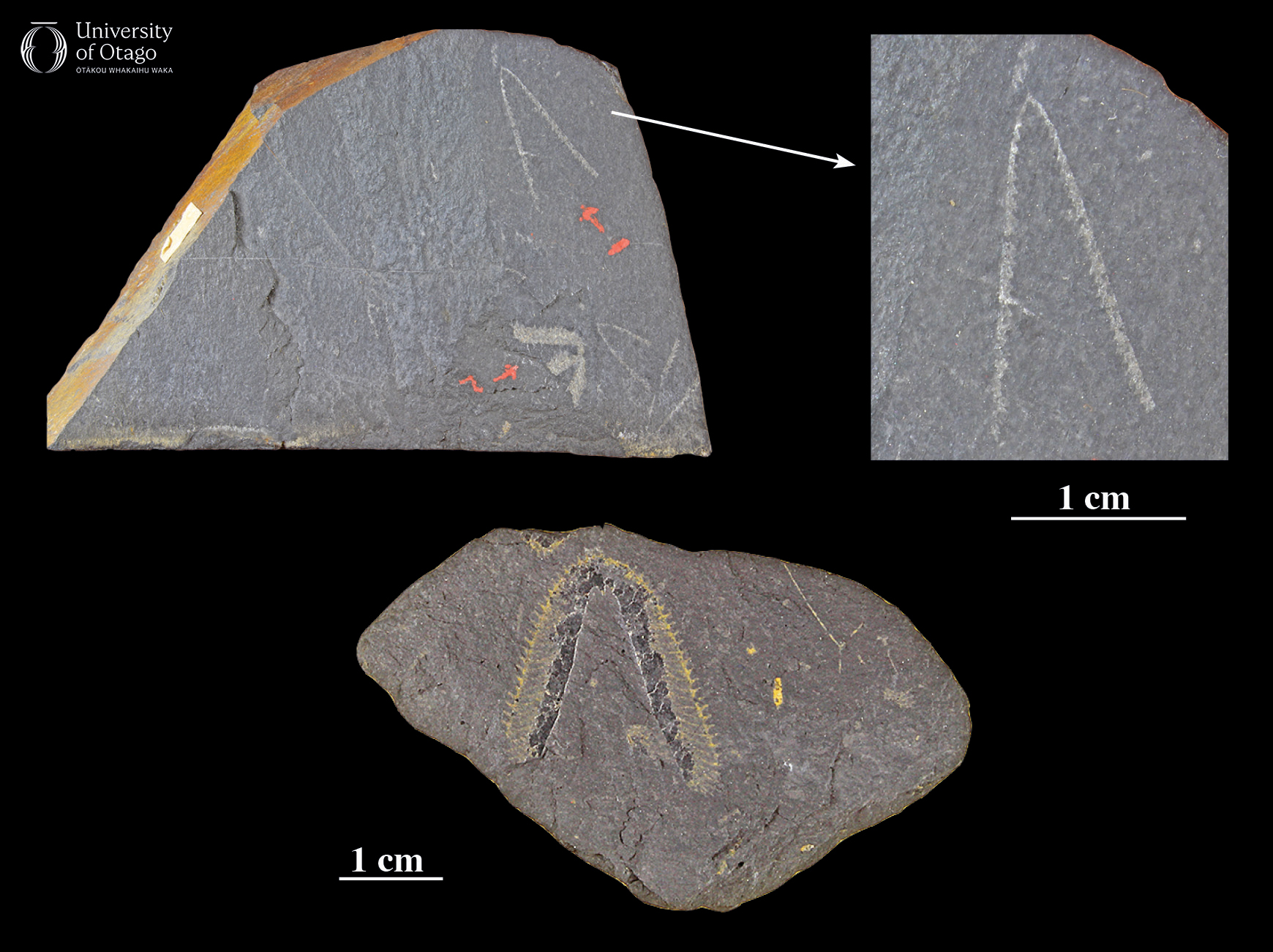59 Floating colonies of ‘rock writing’
Hemichordata, Graptolithina
The Geology Museum has dozens of trays and hundreds of specimens of the small strange-looking animals known as graptolites (the name, meaning ‘written on the rock’, comes from their similarity to pencil markings on the slate rock in which they are preserved).

Examples of graptolite fossils. Image credit: JH Robinson. |
It takes a closer look to recognise that these are flattened fossils of floating graptolite colonies that dominated the surface waters of the world’s oceans between 500 and 400 million years ago. All the examples in the Geology collections are of Ordovician age – about 450 million years old, and many come from remote areas in southwestern Fiordland near Preservation Inlet and Cape Providence.
The colour of the fossils and the dark grey to black colour of the rock are due to carbonaceous (once organic) material in the sedimentary rocks.
Graptolites are small, filter feeding, colonial animals. They were most common in the Ordovician and Silurian periods. The earliest forms (from the Middle Cambrian) were benthic and lived on the sea floor. In the Early Ordovician some graptolites became planktic, living their entire lives floating near the surface of the ocean.
Although small, flattened and seemingly nondescript, myriads of floating graptolites occupied the surface waters of the global oceans for tens of millions of years, carried far and wide by currents. After death, the small animals drifted down through the water column and came to rest on the soft mud and silt on the deep sea floor. Here, conditions were anoxic (low in oxygen) and this helped preserve these fragile fossils in sedimentary rocks which were eventually deeply buried and transformed into shale and slate.
Each graptolite fossil is in fact a small colony, like an apartment block, with each little theca providing a home for a single tiny animal.
Planktic organisms can be very useful when determining the age of rocks. Because they live in the ocean, a particular species of graptolite might have lived over a very wide area. The dead bodies of that species would sink to the ocean floor and some would be fossilised. If that species occurred for a short period of time, geologically speaking, before going extinct then (for example, five million years), then whenever that species is found as a fossil in a rock, that rock can be dated to that time period.
Professor William Noel Benson, head of the Department of Geology at the University of Otago from 1916 to 1949, made large collections of New Zealand planktic graptolites from Fiordland and North West Nelson. With the help of graptolite expert RA Keble, Benson established the succession of graptolite species for the Early Ordovician in New Zealand. Benson described five new species or subspecies and recognised the close correlations between rocks in New Zealand with rocks in Victoria, Australia.
Until recently, graptolites were considered to be long extinct. However, research in the 2010’s has shown that an encrusting living organism known as Rhabdopleura is possibly a living graptolite. Living in small secreted tubes, a Rhabdopleura colony is about 2 cm long with each individual about 0.5 mm long.
—Written by Jeffrey H Robinson and Daphne E Lee
| Specimen number: OU 852 (upper) & OU 850 (lower) | Age: 487 to 443 million years old (Ordovician) |
| Locality: OU 852: Preservation Inlet, Fiordland, & OU 850: Aorangi Mine, Northwest Nelson | Rock Formation: Slaty Creek Formation |
| Collected by: WN Benson and others | |
| Citation: Benson WN, Keble RA, King LC, McKee JT. 1936. The Ordovician graptolites of north-west Nelson, New Zealand, second paper; with notes on other Ordovician fossils. Transactions of the Royal Society of New Zealand. 65:357–382. | |
A collective form of life where many individual organisms live in close association with one another.
486.85 to 443.1 Ma million years ago.
443.1 to 419.6 million years ago.
506.5 to 497 million years ago. The middle Cambrian is the international Miaolingian stage.
Relating to the bottom of a body of water.
Relating to the part of a body of water that is not along the bottom.

